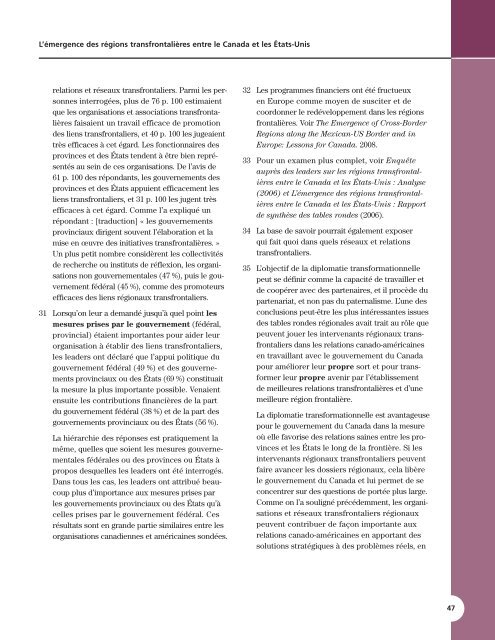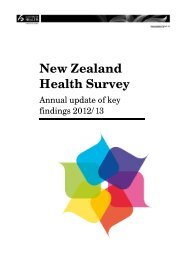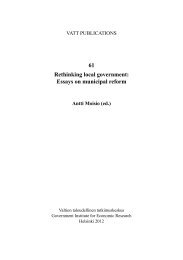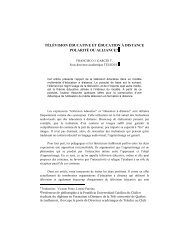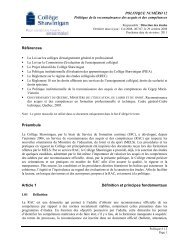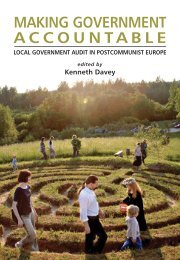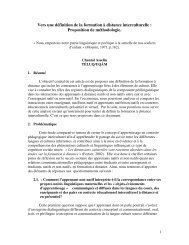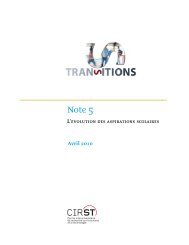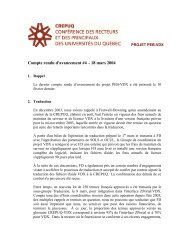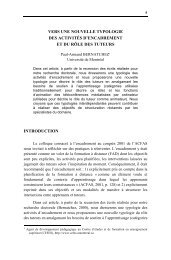L'émergence des régions transfrontalières entre le Canada et les ...
L'émergence des régions transfrontalières entre le Canada et les ...
L'émergence des régions transfrontalières entre le Canada et les ...
You also want an ePaper? Increase the reach of your titles
YUMPU automatically turns print PDFs into web optimized ePapers that Google loves.
L’émergence <strong>des</strong> <strong>régions</strong> <strong>transfrontalières</strong> <strong>entre</strong> <strong>le</strong> <strong>Canada</strong> <strong>et</strong> <strong>le</strong>s États-Unis<br />
relations <strong>et</strong> réseaux transfrontaliers. Parmi <strong>le</strong>s personnes<br />
interrogées, plus de 76 p. 100 estimaient<br />
que <strong>le</strong>s organisations <strong>et</strong> associations transfronta -<br />
lières faisaient un travail efficace de promotion<br />
<strong>des</strong> liens transfrontaliers, <strong>et</strong> 40 p. 100 <strong>le</strong>s jugeaient<br />
très efficaces à c<strong>et</strong> égard. Les fonctionnaires <strong>des</strong><br />
provinces <strong>et</strong> <strong>des</strong> États tendent à être bien repré -<br />
sentés au sein de ces organisations. De l’avis de<br />
61 p. 100 <strong>des</strong> répondants, <strong>le</strong>s gouvernements <strong>des</strong><br />
provinces <strong>et</strong> <strong>des</strong> États appuient efficacement <strong>le</strong>s<br />
liens transfrontaliers, <strong>et</strong> 31 p. 100 <strong>le</strong>s jugent très<br />
efficaces à c<strong>et</strong> égard. Comme l’a expliqué un<br />
répondant : [traduction] « <strong>le</strong>s gouvernements<br />
provinciaux dirigent souvent l’élaboration <strong>et</strong> la<br />
mise en œuvre <strong>des</strong> initiatives <strong>transfrontalières</strong>. »<br />
Un plus p<strong>et</strong>it nombre considèrent <strong>le</strong>s col<strong>le</strong>ctivités<br />
de recherche ou instituts de réf<strong>le</strong>xion, <strong>le</strong>s organisations<br />
non gouvernementa<strong>le</strong>s (47 %), puis <strong>le</strong> gouvernement<br />
fédéral (45 %), comme <strong>des</strong> promoteurs<br />
efficaces <strong>des</strong> liens régionaux transfrontaliers.<br />
31 Lorsqu’on <strong>le</strong>ur a demandé jusqu’à quel point <strong>le</strong>s<br />
mesures prises par <strong>le</strong> gouvernement (fédéral,<br />
provincial) étaient importantes pour aider <strong>le</strong>ur<br />
organisation à établir <strong>des</strong> liens transfrontaliers,<br />
<strong>le</strong>s <strong>le</strong>aders ont déclaré que l’appui politique du<br />
gouvernement fédéral (49 %) <strong>et</strong> <strong>des</strong> gouvernements<br />
provinciaux ou <strong>des</strong> États (69 %) constituait<br />
la mesure la plus importante possib<strong>le</strong>. Venaient<br />
ensuite <strong>le</strong>s contributions financières de la part<br />
du gouvernement fédéral (38 %) <strong>et</strong> de la part <strong>des</strong><br />
gouvernements provinciaux ou <strong>des</strong> États (56 %).<br />
La hiérarchie <strong>des</strong> réponses est pratiquement la<br />
même, quel<strong>le</strong>s que soient <strong>le</strong>s mesures gouvernementa<strong>le</strong>s<br />
fédéra<strong>le</strong>s ou <strong>des</strong> provinces ou États à<br />
propos <strong>des</strong>quel<strong>le</strong>s <strong>le</strong>s <strong>le</strong>aders ont été interrogés.<br />
Dans tous <strong>le</strong>s cas, <strong>le</strong>s <strong>le</strong>aders ont attribué beaucoup<br />
plus d’importance aux mesures prises par<br />
<strong>le</strong>s gouvernements provinciaux ou <strong>des</strong> États qu’à<br />
cel<strong>le</strong>s prises par <strong>le</strong> gouvernement fédéral. Ces<br />
résultats sont en grande partie similaires <strong>entre</strong> <strong>le</strong>s<br />
organisations canadiennes <strong>et</strong> américaines sondées.<br />
32 Les programmes financiers ont été fructueux<br />
en Europe comme moyen de susciter <strong>et</strong> de<br />
coordonner <strong>le</strong> redéveloppement dans <strong>le</strong>s <strong>régions</strong><br />
frontalières. Voir The Emergence of Cross-Border<br />
Regions along the Mexican-US Border and in<br />
Europe: Lessons for <strong>Canada</strong>. 2008.<br />
33 Pour un examen plus comp<strong>le</strong>t, voir Enquête<br />
auprès <strong>des</strong> <strong>le</strong>aders sur <strong>le</strong>s <strong>régions</strong> <strong>transfrontalières</strong><br />
<strong>entre</strong> <strong>le</strong> <strong>Canada</strong> <strong>et</strong> <strong>le</strong>s États-Unis : Analyse<br />
(2006) <strong>et</strong> L’émergence <strong>des</strong> <strong>régions</strong> <strong>transfrontalières</strong><br />
<strong>entre</strong> <strong>le</strong> <strong>Canada</strong> <strong>et</strong> <strong>le</strong>s États-Unis : Rapport<br />
de synthèse <strong>des</strong> tab<strong>le</strong>s ron<strong>des</strong> (2006).<br />
34 La base de savoir pourrait éga<strong>le</strong>ment exposer<br />
qui fait quoi dans quels réseaux <strong>et</strong> relations<br />
transfrontaliers.<br />
35 L’objectif de la diplomatie transformationnel<strong>le</strong><br />
peut se définir comme la capacité de travail<strong>le</strong>r <strong>et</strong><br />
de coopérer avec <strong>des</strong> partenaires, <strong>et</strong> il procède du<br />
partenariat, <strong>et</strong> non pas du paternalisme. L’une <strong>des</strong><br />
conclusions peut-être <strong>le</strong>s plus intéressantes issues<br />
<strong>des</strong> tab<strong>le</strong>s ron<strong>des</strong> régiona<strong>le</strong>s avait trait au rô<strong>le</strong> que<br />
peuvent jouer <strong>le</strong>s intervenants régionaux transfrontaliers<br />
dans <strong>le</strong>s relations canado-américaines<br />
en travaillant avec <strong>le</strong> gouvernement du <strong>Canada</strong><br />
pour améliorer <strong>le</strong>ur propre sort <strong>et</strong> pour transformer<br />
<strong>le</strong>ur propre avenir par l’établissement<br />
de meil<strong>le</strong>ures relations <strong>transfrontalières</strong> <strong>et</strong> d’une<br />
meil<strong>le</strong>ure région frontalière.<br />
La diplomatie transformationnel<strong>le</strong> est avantageuse<br />
pour <strong>le</strong> gouvernement du <strong>Canada</strong> dans la mesure<br />
où el<strong>le</strong> favorise <strong>des</strong> relations saines <strong>entre</strong> <strong>le</strong>s pro -<br />
vinces <strong>et</strong> <strong>le</strong>s États <strong>le</strong> long de la frontière. Si <strong>le</strong>s<br />
intervenants régionaux transfrontaliers peuvent<br />
faire avancer <strong>le</strong>s dossiers régionaux, cela libère<br />
<strong>le</strong> gouvernement du <strong>Canada</strong> <strong>et</strong> lui perm<strong>et</strong> de se<br />
conc<strong>entre</strong>r sur <strong>des</strong> questions de portée plus large.<br />
Comme on l’a souligné précédemment, <strong>le</strong>s organisations<br />
<strong>et</strong> réseaux transfrontaliers régionaux<br />
peuvent contribuer de façon importante aux<br />
relations canado-américaines en apportant <strong>des</strong><br />
solutions stratégiques à <strong>des</strong> problèmes réels, en<br />
47


